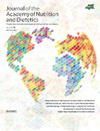摄入限制碳水化合物饮食的成年人中,微量营养素不足情况因脂肪摄入量和类别而异:2007-2018年全国健康与营养调查。
IF 3.5
2区 医学
Q2 NUTRITION & DIETETICS
Journal of the Academy of Nutrition and Dietetics
Pub Date : 2024-11-07
DOI:10.1016/j.jand.2024.11.001
引用次数: 0
摘要
背景:限制碳水化合物的饮食仍然是最受欢迎的减肥和改善总体健康状况的方法之一。最近的证据表明,限制碳水化合物饮食的总体饮食质量较低,但其与微量营养素不足的关系尚未在美国成年人人群中得到很好的描述。目的:1)评估符合可接受宏量营养素分布范围(AMDRs)和限制碳水化合物饮食的美国成年人中未达到每日微量营养素推荐值的发生率:本研究利用 2007-2018 年美国国家健康与营养调查(NHANES)受访者的 24 小时食物和营养素摄入回忆数据:本研究包括 15,029 名年龄≥20 岁、营养素摄入数据完整可靠、未怀孕或哺乳的受访者:主要结果是未达到基于膳食营养素参考摄入量(DRIs)的每日微量营养素推荐值的发生率:采用美国国家癌症研究所的通常摄入量方法来估算通常的膳食摄入量和未达到 DRIs 的美国成年人的患病率:结果:与符合AMDRs标准的参与者相比,限制碳水化合物膳食的参与者摄入不足的比例更高(%):这项研究表明,有不同类型的限制性碳水化合物膳食,可根据脂肪量和类别来区分,每种膳食都与微量营养素的摄入量有关。临床医生可利用这些信息,根据限制碳水化合物饮食的患者所摄入脂肪的数量和类型,为其提供更有针对性的饮食指导。本文章由计算机程序翻译,如有差异,请以英文原文为准。
Micronutrient Inadequacy Differs by Intake of Fat Amount and Class Among Adults That Consume a Restricted Carbohydrate Diet: National Health and Nutrition Examination Survey, 2007-2018
Background
Restricted carbohydrate diets remain among the most popular for weight loss and general health improvement. Recent evidence demonstrates that carbohydrate restricted diets are low in overall diet quality, yet their association with micronutrient inadequacy has not been well characterized at a population-level in adults in the United States.
Objective
To evaluate the prevalence of not meeting daily micronutrient recommendations in US adults that met the Acceptable Macronutrient Distribution Ranges and those who restricted carbohydrate intake to <45% energy, and to examine the effect of total fat and fat class on these results for the restricted carbohydrate group.
Design
This study utilized 24-hour recall data on food and nutrient intake from respondents in the National Health and Nutrition Examination Survey 2007-2018.
Participants/setting
This study included 15 029 respondents who were aged 20 years and older, had complete and reliable nutrient intake data, and were not pregnant or breastfeeding.
Main outcome measures
The main outcome was the prevalence of not meeting daily micronutrient recommendations based on Dietary Reference Intakes.
Statistical analyses performed
The National Cancer Institute’s usual intake methodology was used to estimate usual dietary intake and the prevalence of the US adult population not meeting the Dietary Reference Intakes.
Results
Compared with participants that met the Acceptable Macronutrient Distribution Ranges, those that consumed restricted carbohydrate diets had greater prevalence of inadequacy (% <Estimated Average Requirement) for vitamin A (46.7% vs 33.6%), folate (12.9% vs 4.3%), vitamin C (42.5% vs 23.3%), vitamin D (64.6% vs 61.3%), magnesium (45.2% vs 41.3%), and iron (3.0% vs 1.3%), and lower prevalence of inadequacy for zinc (8.1% vs 12.2%) and vitamin B12 (1.7% vs 2.8%; P < .05 for all comparisons). Restricted carbohydrate diet consumers had a lower likelihood of exceeding the Adequate Intake for vitamin K (57.8% vs 67.6%) and potassium (32.1% vs 39.2%; P < .001 for both), higher likelihood of exceeding the Adequate Intake for choline (16.9% vs 5.6%; P < .001), and a greater proportion exceeded the Chronic Disease Risk Reduction Intake for sodium (92.1% vs 88.5%; P < .001). Fat amount and class in those consuming restricted carbohydrate diets modified many of these associations, but the effects were heterogenous across micronutrients.
Conclusion
This study shows that there are different types of restricted carbohydrate diets that can be characterized by fat amount and class, each with their own association with micronutrient intake. This information can be used by clinicians to provide more targeted dietary counseling to their patients who restrict carbohydrates, depending on the amount and type of fat they consume.
求助全文
通过发布文献求助,成功后即可免费获取论文全文。
去求助
来源期刊

Journal of the Academy of Nutrition and Dietetics
NUTRITION & DIETETICS-
CiteScore
7.20
自引率
10.40%
发文量
649
审稿时长
68 days
期刊介绍:
The Journal of the Academy of Nutrition and Dietetics is the premier source for the practice and science of food, nutrition, and dietetics. The monthly, peer-reviewed journal presents original articles prepared by scholars and practitioners and is the most widely read professional publication in the field. The Journal focuses on advancing professional knowledge across the range of research and practice issues such as: nutritional science, medical nutrition therapy, public health nutrition, food science and biotechnology, foodservice systems, leadership and management, and dietetics education.
 求助内容:
求助内容: 应助结果提醒方式:
应助结果提醒方式:


